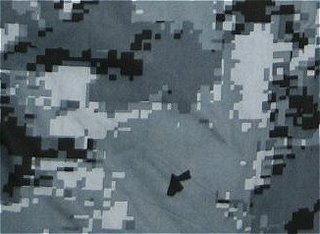


|

|
|
|
Home |
The Mil & Aero Blog
Laser-pitting technology may yield more opportunities for advanced camouflageFriday, February 1, 2008  Posted by John Keller A pair of researchers from the University of Rochester have come up with a way to use ultrashort laser bursts to make nearly imperceptible pockmarks in metal surfaces that can change the metal's color by altering how the it absorbs and reflects light. Aw, so what, you might say. So jewelers might be able to change the gold color in a wedding ring to match the color of the bride or groom's eyes. Cute. But that's not what I'm thinking. Imagine what this could do for the military in terms of camouflage, and for the costs of paint and corrosion protection. This technology has the potential to change the color of metal without paint. Can you just feel the joy in the air as legions of Navy boatswain's mates ponder a future that may not include spending the better part of their lives painting ship hulls and fixtures? Any kidding aside, now, think about what the Army spends every year on painting tanks and other armored combat vehicles, as well as sanding and scraping for rust and other deterioration. Combat vehicles with this technology might be able to be colored appropriately for the field without paint. Technicians could detect and repair rust and corrosion without scraping and repainting. Yet what sounds most interesting is the potential for camouflage. A story this week in The New York Times entitled Lasers Make Other Metals Look Like Gold explains how this technique that uses femtosecond laser pulses can turn color metals orange, gold, blue, black, and other colors. What's not clear, however, is with additional research might this technique be able to render metal invisible to different kinds of sensors? If it can change how metal absorbs and reflects light, then isn't it possible that no light could be reflected? How about confusing colors? It sounds like there's a lot of potential here. The U.S. military has been putting time and resources into new kinds of camouflage for years. Look at the soldiers next time as you pass through the airport. Their battle dress uniforms have camouflage patterns like pixels on a computer screen. DARPA is considering using flexible displays for camouflage. A few years ago the Army started looking at using nanotechnology to create smart paint that not only might be able to warn of rust and corrosion underneath layers of paint, but that also might be able to change its camouflage pattern with different electrical impulses. Looks like this new laser technology is giving the camouflage researchers a few more options. 0 Comments:
<< Home |
Welcome to the lighter side of Military & Aerospace Electronics. This is where our staff recount tales of the strange, the weird, and the otherwise offbeat. We could put news here, but we have the rest of our Website for that. Enjoy our scribblings, and feel free to add your own opinions. You might also get to know us in the process. Proceed at your own risk. 
John Keller is editor-in-chief of Military & Aerospace Electronics magazine, which provides extensive coverage and analysis of enabling electronic and optoelectronic technologies in military, space, and commercial aviation applications. A member of the Military & Aerospace Electronics staff since the magazine's founding in 1989, Mr. Keller took over as chief editor in 1995.  Courtney E. Howard is senior editor of Military & Aerospace Electronics magazine. She is responsible for writing news stories and feature articles for the print publication, as well as composing daily news for the magazine's Website and assembling the weekly electronic newsletter. Her features have appeared in such high-tech trade publications as Military & Aerospace Electronics, Computer Graphics World, Electronic Publishing, Small Times, and The Audio Amateur.
Courtney E. Howard is senior editor of Military & Aerospace Electronics magazine. She is responsible for writing news stories and feature articles for the print publication, as well as composing daily news for the magazine's Website and assembling the weekly electronic newsletter. Her features have appeared in such high-tech trade publications as Military & Aerospace Electronics, Computer Graphics World, Electronic Publishing, Small Times, and The Audio Amateur.
 John McHale is executive editor of Military & Aerospace Electronics magazine, where he has been covering the defense Industry for more than dozen years. During that time he also led PennWell's launches of magazines and shows on homeland security and a defense publication and website in Europe. Mr. McHale has served as chairman of the Military & Aerospace Electronics Forum and its Advisory Council since 2004. He lives in Boston with his golf clubs.
John McHale is executive editor of Military & Aerospace Electronics magazine, where he has been covering the defense Industry for more than dozen years. During that time he also led PennWell's launches of magazines and shows on homeland security and a defense publication and website in Europe. Mr. McHale has served as chairman of the Military & Aerospace Electronics Forum and its Advisory Council since 2004. He lives in Boston with his golf clubs.
Previous Posts
Archives
|
|||||
|
THE MAE WEBSITE AUTHORS ARE SOLELY RESPONSIBLE FOR THE CONTENT AND ACCURACY OF THEIR BLOGS, INCLUDING ANY OPINIONS THEY EXPRESS, AND PENNWELL IS NOT RESPONSIBLE FOR AND HEREBY DISCLAIMS ANY AND ALL LIABILITY FOR THE CONTENT, ITS ACCURACY, AND OPINIONS THAT MAY BE CONTAINED HEREIN. THE CONTENT ON THE MAE WEBSITE MAY BE DATED AND PENNWELL IS UNDER NO OBLIGATION TO PROVIDE UPDATES TO THE INFORMATION INCLUDED HEREIN.
|
||||||
|
|
Home | About Us | Contact Us | Corporate Website | Privacy Policy | Courage and Valor Foundation | Site Map
Also Visit: Laser Focus World | Vision Systems Design | Industrial Laser Solutions Copyright © 2007: PennWell Corporation, Tulsa, OK; All Rights Reserved. | Terms & Conditions | Webmaster |